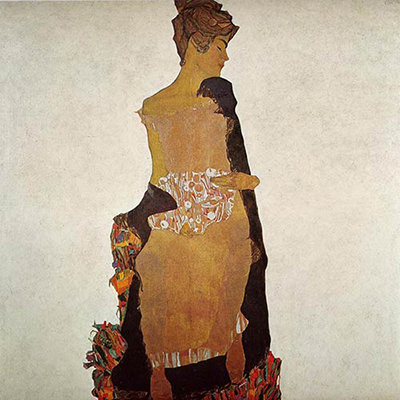Portrait of Gerti Schiele (1909) is among the earliest of Egon Schiele's important works, and was painted while he was still a teenager.
It depicts his younger sister, who frequently sat for Schiele as his model in his formative years. He was close to Gerti, and to some extent the painting shows a softer and more gentle side than many of his later paintings of young women. In 1909, Schiele's quality was just beginning to be recognised by the public; he had had his first exhibition the previous year. He was still strongly influenced by Gustav Klimt, and the two men collaborated at times. However, Schiele was rapidly developing his own style, and Portrait of Gerti Schiele demonstrates this while retaining clear Klimtian influences. The softness in the painting shows Schiele's move away from simple emulation of Klimt's style, as do the large areas of flat colour accented in silver. Schiele was beginning to use a quieter, less elaborate style than that usually favoured by his mentor.
It gives the impression of a two-dimensional representation of a clay or plaster sculpture, with a restrained and dry palette of colours, especially golds and bronzes. This suggests maturity and even decay rather than still-blooming youth. Portrait of Gerti Schiele, created on canvas with oil and pencil, together will small amounts of gold and silver, is now owned by the Museum of Modern Art in New York City. It was passed to MoMA by Ronald Lauder, the founder of the same city's Neue Galerie, and the painting has been hung on loan there for an extended period. Schiele remains a significant draw for contemporary art followers and so this piece will normally be out on display, even though this institution has so many thousands of items within their own collection, most of which cannot be displayed all at the same time.
This brother and sister were close as chosen, often working together to satisfy the creative whims of Egon. He was also particularly interested in portraiture and his sister was a willing subject, happy to help out her brother who received less then encouraging support from his parents with regards his desire to work as an artist. His father would also die relatively young and this perhaps helped the two to strengthen their own relationship. Her figure was also suited to the artist's tastes, similar as it was to his later wife, Edith. For this particular painting, her hair is nicely kept, and she angles her face to the right seemingly in a relaxed mood, entirely unaware of the artist's work. She wears a fairly simple outfit, but elegant, and the background is left entirely blank in line with many of the artist's portraits at this point of his career. This painting is listed as having been produced using oil paint, touches of silver plus also some gold-bronze paint and strokes of pencil on canvas. The fairly square dimensions of this painting means it is approximately one and a half metres in width and height.




